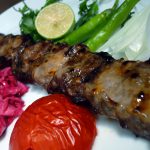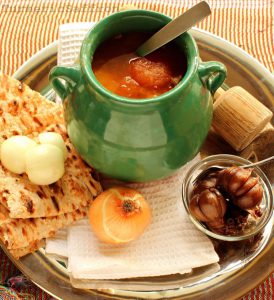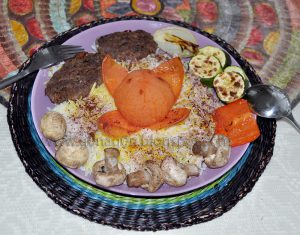
Food in Iran is a fundamental part of Iranian heritage. Their ingredients reflect the geography of Iran, while the savor and colors accent the aesthetic tastes of Iranians. The cuisines are associated with so many social events -births, weddings, funerals; and many other ceremonies and rituals- that culinary traditions are intertwined with a country’s history and religion.
Iranian food is a very important and integral part of Iranians’ life and culture, so important that its ingredients are very frequently used as metaphors for describing beauty. For example:
“Moon-faced beauties have almond-shaped eyes, peachy complexions, pistachio-like mouths, pomegranate colored lips, hazelnut-like noses, red apple cheeks, and lemon-like breasts.”
Situated in the Middle East and West Asia, the Iranian culinary style is unique to Iran, though has historically both influenced and has been influenced by Iran’s neighbouring and conquered regions at various stages throughout its history. Specifically, these have been mutual culinary influences to and from Anatolian cuisine, Caucasian cuisine, Mesopotamian Cuisine, Levantine cuisine, Greek cuisine, Central Asian Cuisine, and minor aspects from Russian cuisine.
Dishes made of lamb, dates, and figs were brought into the Persian diet during the Arab invasion of the 600s.
Three hundred years later, the Turks expanded their Ottoman Empire into Persian territory. The idea of stuffing leaves, vines, fruits, and vegetables with various fillings (Turkish dolma) was reinforced by the Turks. Dolma and kofte (meatballs) have become very popular throughout the Middle Eastern countries. The kebab (cubes of skewered meat) is probably the most important introduction by the Turks—it has become one of Iran’s national dishes. Strong Turkish coffee was also introduced. Once a widely consumed Iranian beverage, it has now fallen behind the popularity of chây (tea). The strong, dark tea is brewed in an urn called a samovar a Russian word.
Iranian food is quite healthy, using only small amounts of red meat (usually lamb or beef), emphasizing larger amounts of grains (especially rice), fruits, and vegetables. Although it is often lumped under the category of general “Middle Eastern” fare, the Iranian cuisine is able to retain its uniqueness in a variety of ways. One of these ways is preparing meals with contrasting flavors, such as a combination of sweet and sour or mild and spicy.
The country’s cuisine is largely based on rice. It is relatively inexpensive and grown locally, making it an affordable and readily available staple in the everyday diet. A typical Iranian meal is often a heaping plate of chelo (plain, cooked rice) topped with vegetables, fish, or meat. It also provides a cool contrast to spicy meat toppings. There are seemingly endless varieties of dishes that can be prepared with rice in Iran.
Nân (bread), a round, flat bread that can either be baked or cooked over a bed of small stones, is the other staple food of Iranian cuisine. There are several varieties, including lavâsh, a very thin, brittle bread served for breakfast, and sangak, a thicker, chewier variety that is usually marked by small “dimples” in the crust. Villages often make their own nân , while those who live in the city are frequently seen leaving bakeries with armfuls of freshly made loaves.
Meat, particularly chicken and lamb, is most commonly eaten as kebabs, pieces of meat served on a skewer. Âsh (soups) and khoresh (stews) make popular entrees to most Iranian meals and often contain such meat. Abgoosht is a hearty soup made of mutton (sheep meat) and chickpeas.
Quinces, pears, grapes, dates, apricots, and Iranian melons flavored with rosewater are typically eaten for dessert. Halva (a sesame treat) and baklava (crisp paper-like pastry layered with nuts and honey) are common throughout the Middle East. Iranians also love ice cream and puddings. Although sugared chây (tea) is the country’s most treasured beverage and ghahvé (coffee) is highly popular, Iranians (particularly children) often enjoy a sweet drink after large meals. Paloudeh, a rose- and lemon-flavored drink, dugh (sour milk or yogurt mixed with sparkling water) and fresh fruit juices can be made at home or bought in cafes and at street stalls.
MEALTIME CUSTOMS
Upon entering an Iranian home and removing one’s shoes at the door, a gift or reciprocated dinner invitation should be offered to the host. When the meal is ready to be served, the host will place large platters of food on top of the sofreh (tablecloth) that rests on top of a floor rug. Diners sit cross-legged in front of individual settings of plates, bowls, and silverware (typically a fork and a spoon). Iranians of the opposite sex (unless related) do not sit next to one another while eating. Talking is also kept to a minimum.
Although most meals will offer bread, rice, and meat (often a kebab ), Iranians often choose what foods will be served by following a set of food rules that originated from ancient Greek medicine. Foods are classified as either “hot” or “cold,” depending on the food’s heating or cooling effect on the individual (rather than the food’s actual temperature). Hot foods include meats, sweets, and eggplant. Yogurt, cucumbers, and fish classify as cold. Iranians try to serve a balance of hot and cold foods. After dinner, chây (tea) is commonly accompanies fresh fruit for dessert, although more elaborate meals or special occasions will include pastries such as baklava or halva .


